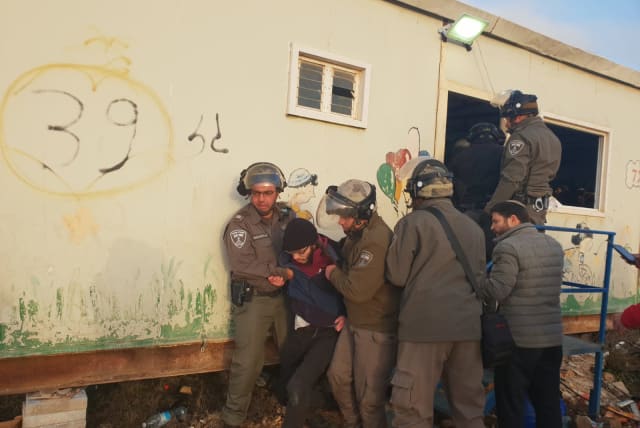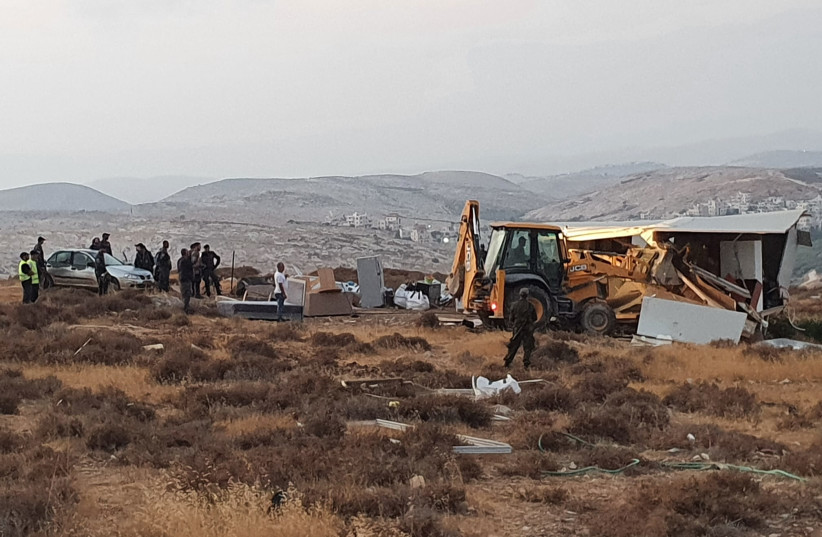Evacuated settlers stranded in temp homes, lack welfare aid - comptroller

From 2012 to 2022, 115 families were evacuated from four settlements and neighborhoods in the West Bank under the said criteria: Migron, Amona, a number of houses in Ofra and Netiv HaAvot in Elazar.
Settlers evacuated from their homes in the West Bank are often stuck in temporary housing for years and suffer from serious deficiencies in their welfare due to a lack of organization and follow-up by the government and other relevant bodies, according to a new report by State Comptroller Matanyahu Englman published on Tuesday.
The report considered cases in which a government decision was issued concerning an evacuation of settlers after the High Court of Justice ruled that the settlers in question were living illegally on private land.
From 2012 to 2022, some 115 families were evacuated from four settlements and neighborhoods in the West Bank under the said criteria: Migron, Amona, the neighborhood of Netiv HaAvot in Elazar and a number of houses in Ofra.
What happened at these evacuated West Bank settlements?
Migron was established in May 2001, northeast of Ramallah. In August 2011, the High Court ruled that the outpost was located illegally on private land and was not approved by the government, meaning that the outpost needed to be evacuated. The government decided after the ruling to establish temporary housing for the evacuees and in September 2012, some 50 families were evacuated from Migron to temporary housing in the Givat Hayekev area nearby.
In 2017, the settlers began building permanent housing in the area and as of June 2022, there have been 28 families living in permanent housing at the site and three more living in temporary housing.
Amona was established in 1995 in the Mateh Binyamin region. In December 2014, the High Court of Justice ruled that the settlement was built illegally on private land and in February 2017, the settlers were also moved to temporary housing.
In 2017, the government issued two decisions concerning the establishment of a new settlement for the evacuees near Shilo called Amichai. In April 2018, some 38 families moved to temporary housing in Amichai. In 2022, there were 11 families in permanent housing and three others were still building their homes. Another 27 families are still living in temporary housing.
Ofra was established in 1975, also in the Mateh Binyamin region. The settlement is located on Highway 60 north of Jerusalem. The High Court ruled in 2015 that nine houses in the settlement were built on privately owned Palestinian land and needed to be demolished. All of the families evacuated have since built permanent housing either in or outside of the settlement.
NETIV HAAVOT was established in the settlement of Elazar in 2001. In 2016, the High Court of Justice ruled that 17 houses in the neighborhood were located on private Palestinian land and needed to be demolished. In February 2018, the government decided to establish temporary housing for the evacuees and provide them with aid. That June, the houses were demolished and the families were moved to temporary housing near Elazar. As of mid-2022, permanent housing for the evacuees has still not been provided.
Last week, the Higher Planning Council of the Civil Administration approved the construction of 433 housing units in the Netiv HaAvot neighborhood.
In 2018, the government issued a decision concerning the timeline and guidelines of the provision of aid to the evacuees from Amona, Ofra and Netiv HaAvot.
“The evacuation and demolition of the buildings, some of which the evacuees lived in for many years, had severe and painful effects both on the individual and the community level,” noted the comptroller. “However, the High Court of Justice ruled that this difficulty does not allow the regulation of illegal construction on private land, and does not justify non-enforcement.”
Deficiencies in the oversight of settlement evacuation decisions
The comptroller’s report published on Tuesday noted that there are deficiencies in the oversight of government decisions concerning settlement evacuations, pointing to two such decisions that were reported as “completed” while in practice they had only been partially carried out or not carried out at all.
Reports on the implementations of government decisions also did not include information about the situation of the evacuees – and the Prime Minister’s Office did not hold follow-up discussions about the decisions, meaning that the government could not identify gaps or issues and deal with them later.
No lesson-learning processes were carried out by the relevant bodies after the evacuations either, according to the report.
THE COMPTROLLER stressed that the need for monitoring is important as its absence has led to evacuees being stuck in temporary housing for months or even years after being evacuated. Settlers evacuated from Amona were in temporary residents for about a year and two months; evacuees from Migron were stuck in temporary housing for seven years.
The long stay of Amona evacuees in temporary residences resulted in unplanned costs of NIS 5 million for the construction of public buildings in Amichai for their welfare.
As of mid-2022, the settlers evacuated from the Netiv HaAvot neighborhood in 2018 had still not received permanent residences, meaning they had been staying in temporary residences for about four years. The evacuees have even been required to pay monthly rent, negatively affecting them economically.
It was also found that the former government secretary did not report to the prime minister on the implementation of the government decision concerning the evacuation of Netiv HaAvot as required every three months – and that the issue of the deficiency in grant payments for rent and maintenance was not discussed by the government.
The decisions concerning the evacuation of Netiv HaAvot also did not take into account the erosion of value of the compensation in relation to how long it would take for them to receive permanent housing. The comptroller’s report found that, as of May 2022, this erosion in compensation value compared to the amount estimated by the government appraiser at the time of the evacuation is estimated to be about NIS 2.5 million in total.
The comptroller recommended that the government secretary raise the issue before the government of the delay in moving the Netiv HaAvot evacuees to permanent residences in order to provide additional grants or assistance.
While the government allocated NIS 6 million for special and exceptional circumstances for the evacuees from Amona, Ofra and Netiv HaAvot, requests made for exceptional cases have not been discussed and the Finance Ministry has not appointed a professional referent as required by the government’s decision. This has led to the allocated budget not being used, which it is assumed affected the evacuees.
The government’s decisions concerning the evacuations also did not refer to the welfare of the evacuees at all, meaning no welfare care plan was built or budgeted. The regional councils in the West Bank subsequently bore the burden of providing welfare services for them. The comptroller recommended that the Welfare Ministry consider a program that would accompany the evacuees for a year after their evacuation.
The comptroller noted that despite a state commission of inquiry established after the disengagement from Gaza and Northern Samaria in 2005 seeing great importance in the need for a central body that would coordinate procedures concerning evacuations, such a body has still not been established.
AMID THE CRITICISM, Englman did note that the evacuees from Amona were moved from temporary residences to permanent residences in Amichai.
“In view of the fact that evacuating families from their homes is a long, sensitive and complex procedure, it is recommended that the government consider appointing one party to lead, coordinate and integrate the work of government ministries and local authorities to speed up and remove barriers in the construction of permanent residences and public buildings for the evacuees,” wrote the comptroller. “This may allow the evacuees to return as quickly as possible to routine family and community life.”
Englman recommended that as long as a permanent entity is not established to follow up on settlement evacuations, the government secretary should be tasked with monitoring the implementation of government decisions concerning such evacuations.
The comptroller additionally recommended that the government adopt a comprehensive plan to speed up the construction of permanent residences and public buildings for evacuees, including a realistic and detailed schedule for the completion of the relevant tasks, taking into account unexpected issues.
He stressed that although the findings of the State Commission of Inquiry on the “handling by the authorized authorities of the evacuees of Gush Katif and Northern Samaria” is available to decision makers, they have still not been implemented regarding evacuations conducted since the Disengagement.
“In the process of evacuating settlement points, many entities are involved, including many government ministries, the IDF, the Civil Administration and regional councils that play a central role in dealing with evacuees who are expected to be absorbed into their jurisdictions,” said the comptroller. “The success of the treatment of evacuees requires the cooperation of all these bodies.”
Jerusalem Post Store
`; document.getElementById("linkPremium").innerHTML = cont; var divWithLink = document.getElementById("premium-link"); if (divWithLink !== null && divWithLink !== 'undefined') { divWithLink.style.border = "solid 1px #cb0f3e"; divWithLink.style.textAlign = "center"; divWithLink.style.marginBottom = "15px"; divWithLink.style.marginTop = "15px"; divWithLink.style.width = "100%"; divWithLink.style.backgroundColor = "#122952"; divWithLink.style.color = "#ffffff"; divWithLink.style.lineHeight = "1.5"; } } (function (v, i) { });

